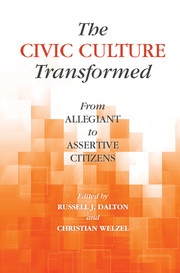39 results
The Good Politician: Folk Theories, Political Interaction, and the Rise of Anti-Politics. By Nick Clarke, Will Jennings, Jonathan Moss, and Gerry Stoker. Cambridge: Cambridge University Press, 2018. 324p. $89.99 cloth, $29.99 paper.
-
- Journal:
- Perspectives on Politics / Volume 18 / Issue 3 / September 2020
- Published online by Cambridge University Press:
- 08 September 2020, pp. 964-965
- Print publication:
- September 2020
-
- Article
- Export citation
Part C - The Impact of Cultural Change
-
- Book:
- The Civic Culture Transformed
- Published online:
- 05 January 2015
- Print publication:
- 31 December 2014, pp 191-192
-
- Chapter
- Export citation
Dedication
-
- Book:
- The Civic Culture Transformed
- Published online:
- 05 January 2015
- Print publication:
- 31 December 2014, pp v-vi
-
- Chapter
- Export citation
References
-
- Book:
- The Civic Culture Transformed
- Published online:
- 05 January 2015
- Print publication:
- 31 December 2014, pp 307-324
-
- Chapter
- Export citation
Contributors
-
- Book:
- The Civic Culture Transformed
- Published online:
- 05 January 2015
- Print publication:
- 31 December 2014, pp xv-xviii
-
- Chapter
- Export citation
5 - Reassessing the Civic Culture Model
-
-
- Book:
- The Civic Culture Transformed
- Published online:
- 05 January 2015
- Print publication:
- 31 December 2014, pp 91-115
-
- Chapter
- Export citation
Part B - Changing Images of Government
-
- Book:
- The Civic Culture Transformed
- Published online:
- 05 January 2015
- Print publication:
- 31 December 2014, pp 89-90
-
- Chapter
- Export citation
12 - From Allegiant to Assertive Citizens
-
-
- Book:
- The Civic Culture Transformed
- Published online:
- 05 January 2015
- Print publication:
- 31 December 2014, pp 282-306
-
- Chapter
- Export citation

The Civic Culture Transformed
- From Allegiant to Assertive Citizens
-
- Published online:
- 05 January 2015
- Print publication:
- 31 December 2014
List of Tables
-
- Book:
- The Civic Culture Transformed
- Published online:
- 05 January 2015
- Print publication:
- 31 December 2014, pp xiii-xiv
-
- Chapter
- Export citation
1 - Political Culture and Value Change
-
-
- Book:
- The Civic Culture Transformed
- Published online:
- 05 January 2015
- Print publication:
- 31 December 2014, pp 1-16
-
- Chapter
- Export citation
Frontmatter
-
- Book:
- The Civic Culture Transformed
- Published online:
- 05 January 2015
- Print publication:
- 31 December 2014, pp i-iv
-
- Chapter
- Export citation
Preface and Acknowledgments
-
-
- Book:
- The Civic Culture Transformed
- Published online:
- 05 January 2015
- Print publication:
- 31 December 2014, pp xxvii-xxx
-
- Chapter
- Export citation
Contents
-
- Book:
- The Civic Culture Transformed
- Published online:
- 05 January 2015
- Print publication:
- 31 December 2014, pp vii-viii
-
- Chapter
- Export citation
Index
-
- Book:
- The Civic Culture Transformed
- Published online:
- 05 January 2015
- Print publication:
- 31 December 2014, pp 325-329
-
- Chapter
- Export citation
Part A - Changing Values
-
- Book:
- The Civic Culture Transformed
- Published online:
- 05 January 2015
- Print publication:
- 31 December 2014, pp 17-18
-
- Chapter
- Export citation
List of Figures
-
- Book:
- The Civic Culture Transformed
- Published online:
- 05 January 2015
- Print publication:
- 31 December 2014, pp ix-xii
-
- Chapter
- Export citation
Ian Marsh and Raymond Miller, Democratic Decline and Democratic Renewal: Political Change in Britain, Australia and New Zealand, Cambridge University Press, 2012, 383pp.
-
- Journal:
- Japanese Journal of Political Science / Volume 14 / Issue 4 / December 2013
- Published online by Cambridge University Press:
- 30 October 2013, pp. 587-589
-
- Article
- Export citation
2 - The Dynamics of Political Representation
-
-
- Book:
- How Democracy Works
- Published by:
- Amsterdam University Press
- Published online:
- 22 January 2021
- Print publication:
- 15 July 2012, pp 21-38
-
- Chapter
- Export citation
Context, Behavior, Outcomes, and Tradeoffs: The Intellectual Contributions of G. Bingham Powell, Jr. to the Study of Comparative Democratic Processes
-
- Journal:
- PS: Political Science & Politics / Volume 44 / Issue 4 / October 2011
- Published online by Cambridge University Press:
- 18 October 2011, pp. 857-864
- Print publication:
- October 2011
-
- Article
-
- You have access
- HTML
- Export citation

